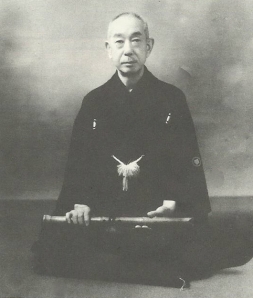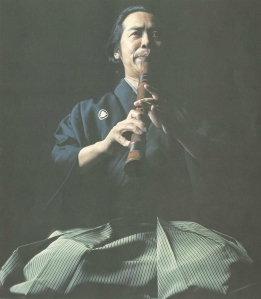Aoki Reibo I
Aoki Reibo II
What is Reibokai? Reibokai is the group of people associated with Aoki Reibo Sensei: the students and teachers he has formed. They live all over Japan and from among them come his biggest fans and patrons; his accountant, publicist and all those who represent and work for him in his career; as well as students who volunteer as photographers and sound men who set up at concerts, record and take photos.
What does Reibo mean? ‘Reibo’ means ‘honor the bell’. The bell is a well-known symbol among shakuhachi players as it refers to the essential self or identity, something the first monk players of the shakuhachi were said to be searching for. The clapperless Asian bell is a perfect symbol of that identity and the paradox of its search: it is completely empty!
The character for bell actually represents the whole school or genealogy, as each of us is given it as the first of a double word name at the time we reach the level of master. We receive Rei from Aoki Sensei, but the second character we choose ourselves, and it is how we are distinguished one from another and on concert programs. A glance at the first character or kanji of other names on a program tells us which geneaology the performer belongs to.
Reibokai representative in the United States
 Sano Reihi Sensei, Tokyo, 2012.
Sano Reihi Sensei, Tokyo, 2012.
Sano Reihi Sensei was Artist in Residence at Wesleyan University and my first shakuhachi teacher. As one of Aoki Sensei’s most promising students, he had been sent to represent Reibokai in Aoki Sensei’s stead. I continued to study for over a decade with Sano Sensei when I was in Tokyo. Once I had reached an acceptable level, I was allowed to study with Aoki Sensei; for many years I had a lesson with each teacher every week. Sano Sensei was not only my shakuhachi teacher; he was a buffer between me and Japanese tradition. If I crossed an invisible line at my lesson with Aoki Sensei, Aoki Sensei would write a letter to Sano Sensei and tell him to correct me! The barriers of hierarchy were not clear to me then, and because Sano Sensei was of a different generation and had lived in the United States, he taught me much more than music alone.
 Aoki Reibo becomes a Living National Treasure in 1999. Note the Heisei Emperor and Empress in the background on the upper left.
Aoki Reibo becomes a Living National Treasure in 1999. Note the Heisei Emperor and Empress in the background on the upper left.
History and future of Reibokai. Reibokai is also a musical family. Aoki Sensei’s grandfather was the first to become interested in the shakuhachi and came up to Yokohama from Kyoto after the Meiji Restoration in 1868, where there were many shakuhachi teachers. He sent two of his four sons to study the shakuhachi before they even started kindergarten, and it is his fourth son Aoki Reibo I, who founded Reibokai in 1909. I am often accompanied by Aoki Sensei’s sister, Fujita Sensei, on koto; his son Aoki Shoji’s wife accompanied me in April, 2012 on Wakakusa (Spring Shoots). As for the continuation of the shakuhachi, Shoji is taking over more of the teaching and performing, and Aoki Sensei’s grandchildren are beginning to be promoted on stage.
 Aoki Sensei and son Shoji in 2012
Aoki Sensei and son Shoji in 2012
 The grandchildren performing in 2012 (on left and right)
The grandchildren performing in 2012 (on left and right)
Typical Reibokai activities The mass shakuhachi performance is something that has yet to be exported from Japan. My first experience of one of these was for the New Year concert of 1984 at NHK Hall in Tokyo. There were over a hundred of us booming away on the shakuhachi. I am easy to spot as I am the only one allowed to wear a color; third row, sixth from the left. It was the first time I wore a kimono.
 Reibokai perform at NHK Hall, 1984
Reibokai perform at NHK Hall, 1984
The one hundredth anniversary of Reibokai is the most recent mass performance I’ve attended. About 200 of us were photographed here. I’m just behind Shoji in the middle.


